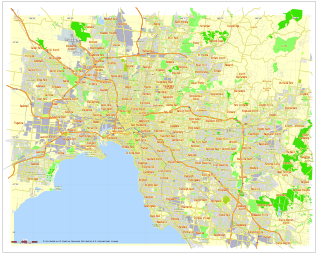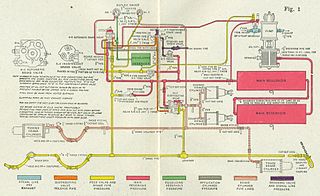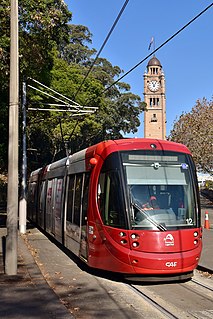
The earliest trams in Australia operated in the latter decades of the 19th century, hauled by horses or "steam tram motors". At the turn of the 20th century, propulsion almost universally turned to electrification, although cable trams lingered in Melbourne. In cities and towns that had trams, they were a major part of public transport assets.

The H type Adelaide tram was a class of 30 trams built by A Pengelly & Co, Adelaide in 1929 for use on the Glenelg tram line. They operated the service until replaced by Flexity Classics in 2006.

The city of Geelong in Victoria, Australia, operated an extensive tramway system from 1912 until 1956, when the service was replaced by buses. Unlike Victoria's other major regional cities, Ballarat and Bendigo, which have kept some track and trams as tourist attractions, no trams or tracks remain in Geelong.

The Ballarat Tramway Museum is an operating tramway museum, located in Ballarat, Victoria, Australia. The museum is run by volunteers and has a fleet of trams which operate on part of the original horse tramway around Lake Wendouree and the Botanical Gardens. It has a large research collection, archive of information and more than 3,500 items about the Ballarat tramways. The trams in Ballarat operated on a large network through the city from 1887 until 1971.
The L-class was a class of six trams ordered from James Moore & Sons by the Prahran & Malvern Tramways Trust (PMTT). However by the time they were delivered in 1921, the PMTT had been taken over by the Melbourne & Metropolitan Tramways Board (MMTB).
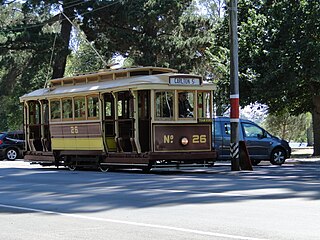
The M-class was a class of 17 trams built by Duncan & Fraser, Adelaide for the Hawthorn Tramways Trust (HTT) as numbers 1 to 10, and 33 to 39. All passed to the Melbourne & Metropolitan Tramways Board on 2 February 1920 when it took over the Municipal Tramway Trusts, becoming the M-class and being renumbered 107 to 116, and 183 to 189.
The N-class was a class of 10 trams built by Duncan & Fraser, Adelaide for the Hawthorn Tramways Trust (HTT) as numbers 11 to 20, all passed to the Melbourne & Metropolitan Tramways Board (M&MTB) on 2 February 1920 when it took over the HTT, becoming the N-class and being renumbered 117 to 126.

The P-class was a class of eight trams built by Duncan & Fraser, Adelaide for the Hawthorn Tramway Trust (HTT) as numbers 25 to 32. All passed to the Melbourne & Metropolitan Tramways Board on 2 February 1920 when it took over the HTT becoming the P-class and being renumbered 131 to 138.
The S-class was a class of 18 trams built by Duncan & Fraser, Adelaide for the Melbourne, Brunswick & Coburg Tramway Trust (MBCTT). The first 12 entered service numbered 1-12. All passed to the Melbourne & Metropolitan Tramways Board (MMTB) on 2 February 1920 when it took over the MBCTT becoming the S-class and renumbered 154-165. The other six were delivered directly to the MMTB as 166-171.

The Tramway Museum, St Kilda is Australia's principal museum of the 19th and 20th century trams of Adelaide, South Australia. It is situated at St Kilda, 24 km (15 mi) north of the centre of Adelaide. Most of the trams operate when rostered along a 1.6 km (1.0 mi) purpose-built track that runs between the museum and a large adventure playground.
To see where this subject fits within the wider context of trams in Adelaide, and for other articles including a less detailed overview article, click [show]in the adjacent panel.

The A type Adelaide tram was a class of 70 drop-end, Californian combination trams built by Duncan & Fraser, Adelaide in 1908/09 for the Municipal Tramways Trust (MTT). They were used on tram lines to Kensington, Marryatville, Maylands, Payneham, Wakerville, North Adelaide, Parkside, Unley and Hyde Park. In later years they were cascaded to quieter services to Croydon and the isolated Port Adelaide network.

The B type Adelaide tram was a class of 30 straight sill, open cross-bench trams built by Duncan & Fraser, Adelaide in 1909 for the Municipal Tramways Trust (MTT). Although popular in summer, they were less so in winter when exposed to inclement weather. Thus in 1917 with the MTT requiring more trams, 41-60 were converted to Californian combination trams, closely resembling the A type trams. When the MTT introduced an alpha classification system in 1923, they were designated the B type. Numbers 41-43 became the A2 type and 44-60 the A1 type. The A2s were used exclusively on the isolated Port Adelaide network.
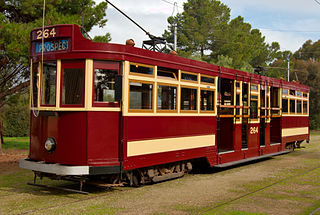
The F type Adelaide tram was a class of 84 bogie, drop centre, combination trams built between 1921 and 1929 for the Municipal Tramways Trust (MTT). All bar three were built by A Pengelly & Co, Adelaide with 262, 283 and 284 being built by the MTT's Hackney workshops. The first 50 were built as the F type, while the last 34 were classified as the F1 type, the latter having an all steel as opposed to partly wooden underframe. Some remained in service until the network closed in November 1958.

The G type Adelaide tram was a class of four single truck Birney trams manufactured by JG Brill Company. They arrived in completely knocked down being assembled by the Municipal Tramways Trust.
The Melbourne tram network began in 1884 with the construction of the Fairfield Horse Tramway. However, the purpose of the line was to increase land prices in the area, and it soon closed during the depression in 1890. The first genuine attempt to construct a tramway network was the construction of the Richmond cable tram line by the Melbourne Tramway & Omnibus Company in 1885. Over the next few years, 16 more cable tram lines were constructed, as well as numerous other horse tramways. The depression of the early 1890s slowed further expansion of the cable network. The first electric tram line was the Box Hill and Doncaster tramway which opened in 1889. This was a pioneering line in what was then the countryside and thus didn't receive much patronage. It closed in 1896. The next attempt at an electric tramway was Victorian Railways' St Kilda to Brighton line, which opened in 1906. Later that year, the North Melbourne Electric Tramway and Lighting Company opened lines to Essendon and Maribyrnong. Many local councils formed their own tramway trusts and built tramways within their own constituency. The most successful of these was the Prahran and Malvern Tramway Trust.








